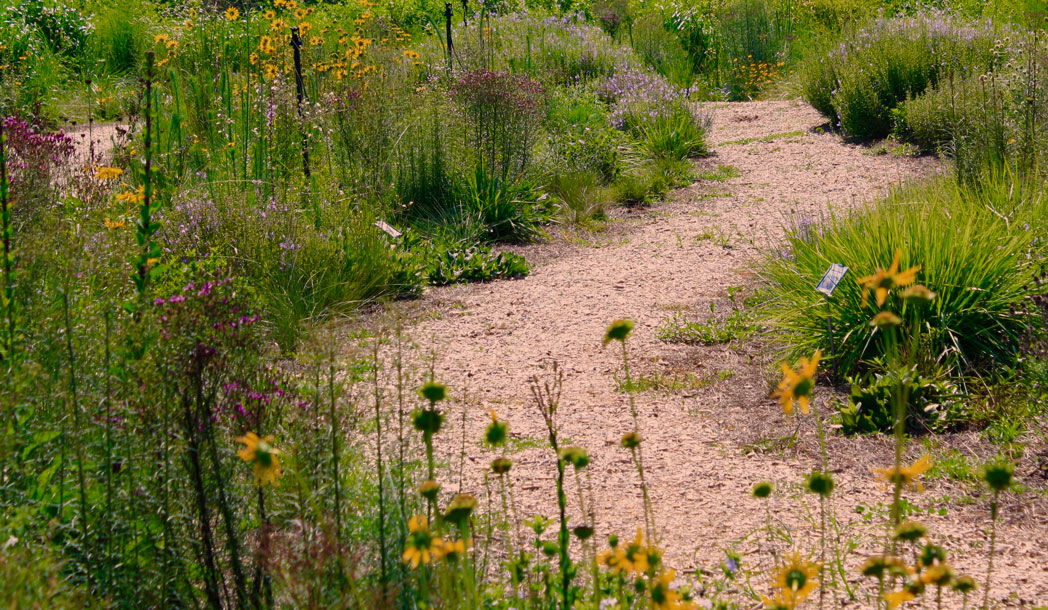Starting a Wildflower Garden from Seed
Follow these 12 steps to establish a small planting of native wildflowers from seed.

1. Location, location, location
Choose a site that is sunny most of the day, has well-drained soil, and is free of weeds.
2. Determine suitable wildflower species
Common wildflowers are generally adaptable to a range of gardening conditions and are generally listed as suitable for North, Central or South Florida
where they will thrive naturally in nature. Our website has many resources to help determine what species are appropriate for your garden. Find seed packets and mixes at www.FloridaWildflowers.com.
3. Determine when to sow seeds
In North Florida, sow seed from mid-September to mid-October. In Central Florida, sow in mid-October to end of December. In South Florida, sow in November through January. Planting can be extended to mid-April by using irrigation. Planting seeds during hot months should be avoided, because the soil’s surface dries out too quickly.
4. For areas with turf grass
While some gardeners prefer to chemically eradicate weeds with glyphosate,* the Foundation recommends soil solarization as the best means of obtaining a weed-free planting site. This process takes time and patience, and must be done from June to mid-August. First, remove existing turf and weeds with a shovel. Then till the soil 12 to 18 inches deep, breaking up soil clods (the finer the soil texture, the better). Remove sticks, roots and other debris brought up by tilling. Rake the surface of the area until smooth, then water until slightly moist but not soggy. Cover with clear plastic that is 3–6 mil thick (1 mil is equal to .001 or 1⁄1000 inch.) To prevent wind from lifting the sheet, bury its edges in up to 12 inches of soil. Solarization takes about six weeks. Leave the plastic in place until the seed is sown. For more information, visit FlaWildflowers.org/solarize.
5. For areas with bare soil
Scratch or firm up soil. Soil-to-seed contact is critical, so one day before seeding, or just prior to seeding, lightly scratch firmer soils with a rake. Sandy soils might have to be firmed by rolling to ensure that seeds do not sink too deeply.
6. Sow seeds
This method distributes seeds evenly over the garden:
- Fill a large bucket about halfway with sand or vermiculite; slightly moisten the sand or vermiculite.
- Add half of the seeds and mix thoroughly.
- Starting at one end of the garden, spread the mixture evenly over the site.
- Repeat the above steps with the other half of the seeds but start spreading them from the opposite end of the plot.
7. Place seeds in contact with soil
Walk over the site to ensure good seed to soil contact. If the area is large, consider renting a sod roller. Seeds should remain on top of the soil or be covered 1⁄8 inch to 1⁄2 inch deep at most. Generally, the smaller the seed, the more shallowly it needs to be planted. Most seeds need light to germinate! Water seeds gently after planting to help settle them in the soil, then wait until spring for further irrigation if rain is not sufficient for growth.
8. Be patient!
Though some species will germinate quickly, others may need to rest in the soil for 3 to 4 months. In that time they will naturally receive the water and fluctuating temperatures needed to stimulate their emergence at the right time in early spring.
9. Irrigate
Keep the planting site moist, but not wet. For loamy soils, that might mean watering 2 to 4 times per week with about 1⁄4 to 1⁄2 inches of water; sandy soils might need daily watering. Monitor the soil for moisture and adjust watering accordingly. After wildflowers germinate, irrigate with about 1⁄2-inch of water only if plants show signs of drought stress.
10. Keep out the weeds
To minimize weed interference, remove seedlings of grass or nonwildflowers by hand after wildflowers have emerged and been identified. To help identify your wildflowers, photos of young plants showing leaf shape and arrangement can be found on the Florida Wildflower Foundation website at flawildflowers.org/resources/pdfs/Publications/SeedlingImageProject_Report-Ver2007-96DPI_Images.pdf.
11. Do not fertilize
Many of Florida’s native wildflower species are adapted to poor soils. Excess fertilization will promote vegetative growth over flowering, might make wildflowers more susceptible to insect and disease pests, and will promote weed growth. If plants appear nutritionally deficient in the growing season, a light layer of compost or several applications of a half-strength liquid fertilizer can be applied to correct the problem.
12. Wait until seeds have matured
Your wildflowers will reseed themselves if given the opportunity, so wait until seeds have matured on plants before deadheading or mowing. For many species, seeds need 2 to 4 weeks to mature after plants bloom. Seeds can be dried, stored in plastic bags at 40F, and replanted in the fall in your garden.
* All chemicals should be used in accordance with directions on the manufacturer’s label.
